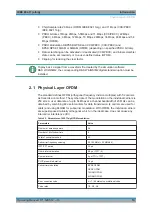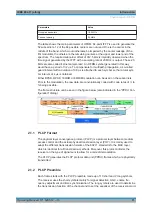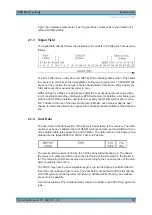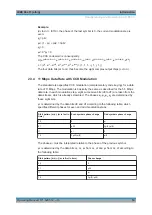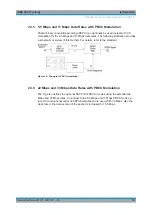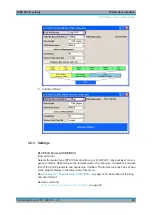
WLAN User Interface
IEEE 802.11 (a/b/g)
24
Operating Manual 1171.5283.12 ─ 18
"802.11a"
The standard supports OFDM (orthogonal frequency division multi-
plexing). This modulation is defined by the IEEE 802.11a specification
in the 5 GHz frequency band.
"802.11b"
The standard includes the modulation mode CCK (complementary
code keying) and the data rates 5.5
Mbps and 11
Mbps. PBCC
(packet binary convolutional coding) can optionally be used instead of
CCK modulation for the 5.5
Mbps and 11
Mbps data rates.
"802.11g"
Standard 802.11g extends standard 802.11b with higher transmission
rates. 802.11g contains the previous 802.11b modes and also inte-
grates the OFDM method used in 802.11a for frequencies in the 2.4
GHz band.
Remote command:
[:SOURce<hw>]:BB:WLAN:STANdard
Physical Layer Mode
Selects the physical layer mode.
"OFDM"
The OFDM (orthogonal frequency division multiplexing) physical layer
supports a frame-based transmission. The OFDM signal is divided
into 52 carriers. The symbol rate of the modulation on the individual
carriers is 250 kHz. A user data rate of up to 54 Mbps at a channel
bandwidth of 20 MHz can be obtained.
This is achieved by combining 48 useful carriers for data transmission
(4 carriers are used for pilots) and using 64QAM for subcarrier modu-
lation. With OFDM, the individual carriers are superimposed mutually
orthogonal, which, in the ideal case, does not cause any intercarrier
interference (ICI).
"CCK"
The CCK (complementary code keying) physical layer mode is used
for the 5.5
Mbps and 11
Mbps data rates.
"PBCC"
The PBCC (packet binary convolutional coding) physical layer can
optionally be used instead of CCK modulation and extents 802.11b to
higher data rates (22 Mbps).
Remote command:
Simulation Mode
Selects the simulation mode.
General Settings for WLAN Signals

